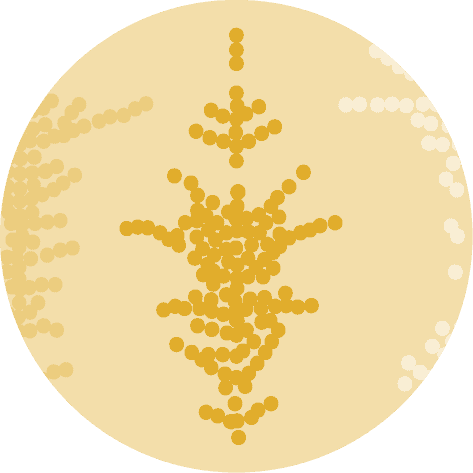Libraries
As usual, a couple of libraries are required.
Matplotlib and Seaborn are the most common libraries when it comes to visualize data with Python. In this example, seaborn will be used to create most of the figure, and matplotlib will just allow to customize the axes and the grid.
pandas is a very handy library used for data wrangling.
# libraries & dataset
import pandas as pd
import seaborn as sns
import matplotlib.pyplot as pltDataset
The dataset is stored here. It can be loaded into our working environment thanks to the read.csv() function of pandas.
It is a data frame with 2 columns. name provides the group the data point is assigned to. dist provides a numerical value for the data point.
path = 'https://raw.githubusercontent.com/holtzy/The-Python-Graph-Gallery/master/static/data/sqa_data.csv'
data = pd.read_csv(path)Now, data is an object containing our dataset. We are ready to start the plot.
Color palette
In this example I suggest to pick color manually since only 3 groups are to be displayed.
The code below builds 2 dict. The first one, swarmplot_palette, setup the colors for the dots that will appear over the violin chart. violin_palette setup 3 darker colors for the violin shapes below.
# Palettes for the areas and the datapoints
# Light colors for the dots
swarmplot_palette = {'Sqa_par':'#8f96bf', 'Sqa_bif':'#ebb0e5', 'Sqa_zz':'#9feed3'}
# Dark colors for the violin
violin_palette = {'Sqa_par':'#333c70', 'Sqa_bif':'#90367c', 'Sqa_zz':'#34906c'}Violin
A violin chart shows the distribution of each group as a density. It is straightforward to build with seaborn thanks to its violinplot() function.
The violin plot section of the gallery displays many examples with both seaborn and matplotlib. In the code below, the palette option is used to call the violin_palette we built just before.
# create figure and seaborn context
sns.set_context('notebook', font_scale=1.2)
fig, ax = plt.subplots(figsize=(8,4))
# Plot the violin
ax = sns.violinplot(y="dist",
x="name",
data=data,
palette=violin_palette,
scale='count',
inner=None
)
plt.show()That's it 🔥!
Now, let's improve the quality of this chart by showing individual observations on top of each shape.
Beeswarm on top
A violin chart is a powerful way to compare distribution across groups.
However, it is important to understand the it hides the individual observations which can be misleading. For instance, if a group has only 10 observations and another has 10000, it will be impossible to guess.
Adding individual data points on top of the figure is a very good way to avoid this issue. The beeswarm chart is a dataviz technique that slightly shifts data points to avoid overlaps. It can easily be created thanks to the swarmplot of seaborn. The code below shows how to do it.
# create figure and seaborn context
sns.set_context('notebook', font_scale=1.2)
fig, ax = plt.subplots(figsize=(8,5))
# Plot the violin
ax = sns.violinplot(y="dist",
x="name",
data=data,
palette=violin_palette,
scale='count',
inner=None
)
# Plot the swarmplot on top
ax = sns.swarmplot(y="dist",
x="name",
data=data,
color="white",
edgecolor="gray",
s=6, # Circle size
palette=swarmplot_palette
)
# Change axis labels, ticks and title
ax.set_xticks([0, 1, 2], ['Parallel','Bifurcated','Zig-zag'])
ax.set_xlabel('Squaramide CCSD systems')
ax.set_ylabel(r'$HB distance\ (\AA)$')
plt.ylim(1.5, 3.5)
# Add horizontal grid
ax.grid(axis='y')
ax.set_axisbelow(True)
plt.show()Going further
This post explains how to build a violin chart with individual data points on top.
You might be interested in adding number of observations in violin plot. You can also check out this beautiful violin chart with statistics on top.






